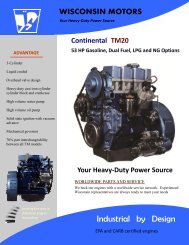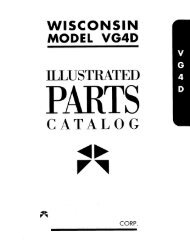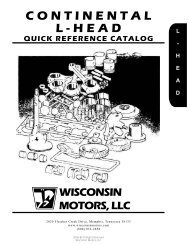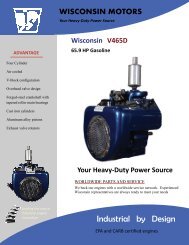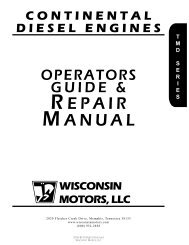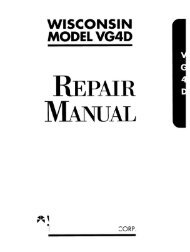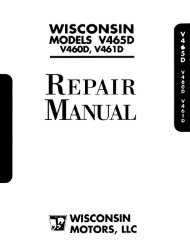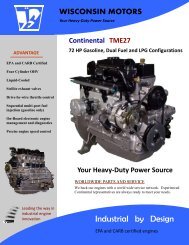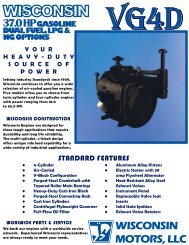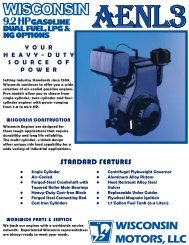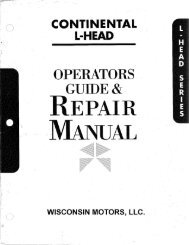W2-880 Tjd, Thd, Th - Repair - Wisconsin Motors
W2-880 Tjd, Thd, Th - Repair - Wisconsin Motors
W2-880 Tjd, Thd, Th - Repair - Wisconsin Motors
Create successful ePaper yourself
Turn your PDF publications into a flip-book with our unique Google optimized e-Paper software.
CLUTCH REDUCTION UNIT<br />
ADJUSTMENT (Fig. 27)<br />
<strong>Th</strong>e clutch in the clutch reduction unit is the ~;ame as used in the<br />
clutch take-off assembly. Clutch adjustment is made thru two<br />
pipe tap openings; one for the adjustment Iockscrewand the<br />
other for turning the adjusting ring. If one of the taps is<br />
inaccessible, adjustment can be made thru ju st one opening, by<br />
rotating clutch slightly after adjustment lockscrew is loosened.<br />
Remove the two adjusting plugs; one on the left hand side of<br />
the housing, and the other on the opposite side near the top.<br />
Disengage the clutch and turn engine over slowly with the<br />
starting crank until the adjustment Iockscrewis visible thru<br />
oneof the pipe tap openings. Loosen Iockscrewone full turn,<br />
or enough to relieve the tension of the lock against the notches<br />
on the adjusting ring. <strong>Th</strong>en, thru the other pipe tap opening,<br />
turn the adjusting ring with a screw driver, one notch at a time<br />
in a clockwise direction (viewing from take-off end), until<br />
very firm pressure is required to engage the clutch with the<br />
lever. Tighten adjustment lockscrew and mount pipe plugs,<br />
when adjustment is completed.<br />
REDUCTION GEARS (Fig. 28)<br />
Reduction gears are furnished with s;everal different<br />
ratios, some with spur gears, others with chain drives.<br />
All are of the same general design, except that some<br />
are furnished with clutches, others without.<br />
Use same grade oil as used in engine crankcase.<br />
Several plugs are furnished so that lubrication may be<br />
properly taken care of regardless of the position of installation.<br />
<strong>Th</strong>ere will always be one plug on top to be<br />
used for filling oil, one plug below :for draining oil,<br />
and a plug on the side, slightly above bottom, for the<br />
oil level. <strong>Th</strong>e oil should always be filled when the<br />
engine is at rest. When oil becomes dirty it should be<br />
drained while the engine is hot, and :fresh oil added.<br />
<strong>Th</strong>e frequency at which these oil changes should be<br />
made depends entirely on the kind of s~ervice in which<br />
these gears are used, but even with light service;<br />
Change oil at least every 500 hours of operation.<br />
Add sufficient oil between changes to keep oil up to<br />
he level plug opening.<br />
OIL FILLER PLUG<br />
WINTER STORAGE<br />
To protect the cylinders, pistons, rings and valves<br />
and keep them from rusting and sticking, a half and<br />
half mixture of kerosene and good "gasoline engine"<br />
oil (the same kind of oil as used in the crankcase of<br />
the engine), should be injected into the pipe top<br />
opening on the intake manifold while the engine is<br />
warm and running at moderate speed. About a quarter<br />
of a pint is necessary, or enough so that a heavy<br />
bluish smoke will appear at the exhaust. <strong>Th</strong>e ignition<br />
switch should then be shut off and the engine stopped.<br />
<strong>Th</strong>is fogging operation will leave a coating of oil on<br />
the above mentioned parts, protecting them from the<br />
atmosphere.<br />
Drain crankcase oil while engine is warm.<br />
Drain fuel lines, carburetor, fuel pump and tank, to<br />
prevent lead and gum sediment from. interfering with<br />
future operation. Gasoline fumes from gradual evaporation<br />
is a dangerous fire hazard.<br />
<strong>Th</strong>e air cleaner and filter element should be thoroughly<br />
cleaned. Tape or otherwise seal off the exhaust and<br />
air cleaner openings for the duration of storage.<br />
<strong>Th</strong>e outside of the engine, including the cooling fins<br />
on the cylinder and head, should be thoroughly cleaned<br />
of all dirt and other deposits. All exposed unpainted<br />
metal parts should be coated with grease or heavy oil.<br />
Before starting the engine, after the storage period,<br />
remove crankcase drain plug so that any condensation<br />
which may have collected may be drained, before new<br />
crankcase oil is added. It is highly recommended to<br />
remove the crankcase oil base and scrub off allsediment<br />
which may have collected there. When replacing<br />
the engine base, a new gasket should be used.<br />
Fill crankcase with the correct grade of oil to the full<br />
mark on the saber. Do not use any oil heavier than<br />
SAE No. 30. Add oil to air cleaner if oil bath type is<br />
used. {Refer to Lubrication and .4Jr Cleaner.)<br />
It is advisable to use new spark plugs at the beginning<br />
of the operating interval, especially if the engine<br />
has given considerable service.<br />
Refuel engine and follow the starting instructions as<br />
shown on preceding pages of this manual.<br />
It is suggested that equipment be stored inside a<br />
building. If this is not possible, protect the engine<br />
from the weather by a proper covering.<br />
O~L LEVEL PLUGS<br />
Fig. 28<br />
OIL DRAIN PLUG<br />
TROUBLES<br />
CAUSES AND REMEDIES<br />
<strong>Th</strong>ree prime requisites are essential to starting and<br />
maintaining satisfactory operation of gasoline engines.<br />
<strong>Th</strong>ey are:<br />
1. A proper fuel mixture in the cylinder.<br />
2. Good compression in the cylinder.<br />
3. Good spark, properly timed, to ignite the mixture.<br />
If all three of these conditions do not exist, the en-<br />
2O



